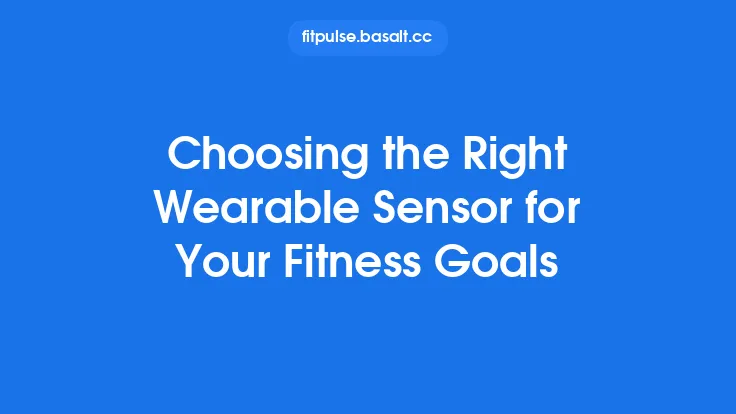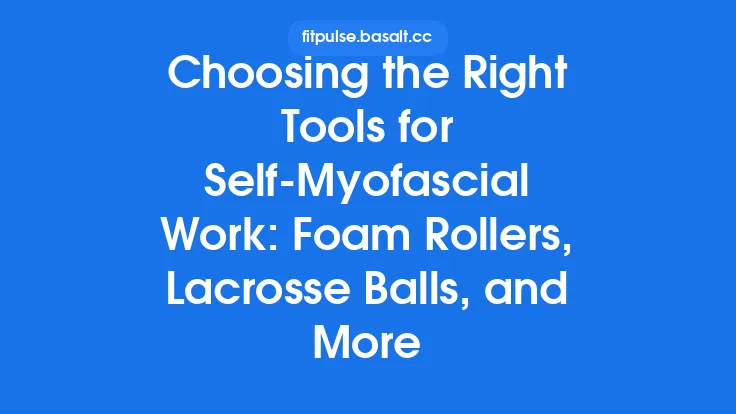Sleep tracking has become a cornerstone of modern athletic recovery strategies, yet the sheer variety of devices and data points can leave even seasoned competitors wondering which numbers truly matter. While the allure of flashy dashboards and “sleep score” widgets is strong, the most effective approach hinges on aligning the metrics you monitor with the specific recovery demands of your sport, training load, and personal physiology. Below is a comprehensive guide to the tools available, the key metrics that drive performance‑focused recovery, and a framework for selecting the right combination for any athlete.
Understanding the Landscape of Sleep‑Tracking Technologies
Wearable Sensors
Most athletes already wear a smartwatch, fitness band, or chest strap during training. Modern wearables embed accelerometers, gyroscopes, optical heart‑rate sensors, and sometimes skin‑temperature probes. When worn overnight, they can capture:
- Movement‑based sleep/wake detection (actigraphy)
- Heart‑rate variability (HRV) and resting heart rate trends
- Respiratory rate via subtle chest‑wall motion
- Skin temperature fluctuations that correlate with circadian phase
Because these devices are already part of the athlete’s daily routine, they offer a low‑friction way to collect longitudinal data.
Dedicated Bedside Monitors
Products that sit on the mattress or under the sheet (e.g., radar‑based or pressure‑sensing pads) provide a non‑intrusive alternative. They typically excel at:
- High‑resolution movement tracking without the need for a wrist‑worn device
- Sleep stage estimation using proprietary algorithms that combine motion, heart‑rate, and breathing signals
- Environmental integration (room temperature, humidity) for a holistic view of sleep conditions
These monitors are ideal for athletes who find wearing a device uncomfortable during sleep or who want a “set‑and‑forget” solution.
Smartphone Apps with External Sensors
Some apps pair with Bluetooth‑enabled accessories (e.g., finger‑clip pulse oximeters) to capture additional data such as blood‑oxygen saturation (SpO₂). While not a primary metric for most athletes, SpO₂ can be valuable for those training at altitude or recovering from respiratory illnesses.
Hybrid Systems
A growing segment of platforms combines wearable data with manual inputs (e.g., perceived sleep quality, training load, nutrition) to generate a composite recovery score. These systems often integrate with existing training management software, allowing coaches to view sleep metrics alongside performance analytics.
Core Metrics That Matter for Athletic Recovery
1. Total Sleep Time (TST)
The absolute amount of sleep obtained each night remains a fundamental indicator of recovery capacity. For most adult athletes, 7–9 hours is the target range, but sport‑specific demands (e.g., endurance vs. strength) may shift the optimal window slightly. Consistently falling below the individualized threshold can impair glycogen restoration, protein synthesis, and hormonal balance.
2. Sleep Efficiency
Calculated as the ratio of time spent asleep to time spent in bed, sleep efficiency reflects how quickly an athlete transitions into restorative sleep. Values above 85 % are generally considered good. Low efficiency often signals fragmented sleep, which can blunt the benefits of even a long TST.
3. Sleep Latency
The time it takes to fall asleep after lights‑out. While a short latency (5–20 minutes) is typical for well‑rested individuals, prolonged latency can indicate heightened sympathetic activity or inadequate pre‑sleep preparation—both of which may compromise recovery.
4. Wake After Sleep Onset (WASO)
The cumulative duration of awakenings after initial sleep onset. Elevated WASO reduces the proportion of deep, restorative sleep and can be a red flag for overtraining or stress.
5. Heart‑Rate Variability (HRV)
HRV measures the variation in time intervals between heartbeats and serves as a proxy for autonomic nervous system balance. Higher nocturnal HRV generally correlates with a parasympathetic‑dominant state conducive to tissue repair. Tracking HRV trends over weeks can reveal early signs of training‑induced fatigue before performance declines become apparent.
6. Resting Heart Rate (RHR)
A nightly RHR that trends upward may indicate cumulative stress or insufficient recovery. Conversely, a stable or decreasing RHR often reflects successful adaptation to training loads.
7. Respiratory Rate (RR)
Night‑time breathing patterns can uncover subtle respiratory strain, especially in athletes who engage in high‑intensity interval training (HIIT) or altitude exposure. An elevated RR at rest may signal incomplete recovery or lingering inflammation.
8. Skin Temperature Rhythm
The nocturnal drop in peripheral skin temperature is a hallmark of the body’s transition into deep sleep. Persistent disruptions in this pattern can hint at thermoregulatory issues, which may be relevant for athletes training in extreme climates.
9. Sleep Consistency (Chronotype‑Adjusted Bedtime/Wake Time)
Even if total sleep quantity is adequate, irregular sleep‑wake times can impair circadian alignment, leading to suboptimal hormone release and metabolic function. Tracking the variance in bedtime and wake time provides insight into the regularity of an athlete’s sleep schedule.
Matching Metrics to Sport‑Specific Demands
| Sport / Training Focus | Priority Metrics | Rationale |
|---|---|---|
| Endurance (marathon, cycling) | TST, HRV, RR, Sleep Efficiency | High aerobic load stresses cardiovascular and respiratory systems; HRV and RR are sensitive to cumulative fatigue. |
| Strength/Power (weightlifting, sprinting) | TST, Sleep Efficiency, RHR, WASO | Muscle repair and neuromuscular recovery benefit from uninterrupted deep sleep; RHR reflects systemic stress. |
| Team Sports (soccer, basketball) | Consistency, Latency, HRV, TST | Variable training and travel schedules demand stable sleep patterns; HRV tracks overall load. |
| Combat/High‑Intensity (MMA, rugby) | WASO, HRV, RHR, Skin Temp | Frequent high‑intensity bouts elevate sympathetic tone; monitoring fragmentation and autonomic balance is critical. |
| Altitude or Heat Training | SpO₂ (optional), RR, Skin Temp, HRV | Environmental stressors affect oxygen saturation and thermoregulation; these metrics help gauge adaptation. |
Building a Practical Sleep‑Tracking Protocol
- Define Baseline
- Record at least 14 consecutive nights of data under typical training conditions.
- Identify personal averages for TST, HRV (nightly RMSSD), and RHR.
- Set Individual Targets
- Use baseline values to establish realistic thresholds (e.g., maintain HRV within ±5 % of baseline, keep WASO < 30 min).
- Adjust targets based on upcoming training blocks (e.g., higher HRV tolerance during taper weeks).
- Integrate with Training Load
- Pair sleep metrics with session RPE, volume, and intensity scores.
- Look for patterns: a dip in HRV concurrent with rising training load may signal the need for a recovery day.
- Implement a Review Cadence
- Daily: Quick glance at sleep efficiency and latency to catch acute issues.
- Weekly: Summarize trends in TST, HRV, and consistency.
- Monthly: Conduct a deeper analysis, correlating sleep data with performance outputs (e.g., time trial results, strength gains).
- Act on Insights
- If HRV drops > 10 % for three consecutive nights, schedule a low‑intensity session or active recovery.
- Persistent high WASO (> 45 min) warrants investigation into potential external disruptors (e.g., training timing, nutrition timing) even though detailed environmental factors are beyond this article’s scope.
Evaluating Device Accuracy and Suitability
| Criterion | What to Look For | Why It Matters |
|---|---|---|
| Validation Studies | Peer‑reviewed research comparing device output to polysomnography (PSG) | Ensures the metric (e.g., HRV) is reliable enough for performance decisions. |
| Sampling Rate | ≥ 1 Hz for heart‑rate and motion sensors | Higher resolution captures subtle autonomic fluctuations. |
| Battery Life & Comfort | Minimum 7‑night battery life, lightweight design | Reduces data gaps and user compliance issues. |
| Data Export Options | CSV, API access, integration with training platforms | Facilitates custom analytics and coach‑athlete collaboration. |
| Privacy & Security | End‑to‑end encryption, GDPR/CCPA compliance | Protects sensitive health data, especially for professional teams. |
| Cost vs. Benefit | Balance between price point and metric depth | Over‑investing in niche metrics (e.g., detailed sleep stage breakdown) may not yield additional performance gains for many athletes. |
Case Study: Translating Metrics into Performance Gains
Athlete Profile: 27‑year‑old elite distance runner, training 120 km/week with two high‑intensity interval sessions.
Toolset: Wrist‑worn optical sensor (HRV, RR, skin temperature) + bedside radar monitor (movement, sleep efficiency).
Baseline (2 weeks):
- TST = 7 h 15 min
- Sleep efficiency = 82 %
- Nightly HRV (RMSSD) = 55 ms (± 4)
- WASO = 38 min
Intervention: After a 3‑week training block, HRV fell to 45 ms and WASO rose to 55 min. The athlete added a recovery day and shifted the evening HIIT session 2 hours earlier.
Outcome (next 2 weeks):
- HRV rebounded to 52 ms
- WASO dropped to 30 min
- TST increased to 7 h 45 min (due to more consistent bedtime)
- 5‑km time trial improved by 3 seconds.
Takeaway: Monitoring HRV and WASO provided an early warning system, allowing a targeted training adjustment that translated into measurable performance improvement.
Common Pitfalls and How to Avoid Them
- Over‑reliance on a Single Metric
Solution: Use a composite view. A temporary dip in HRV may be benign if TST and efficiency remain stable.
- Ignoring Individual Variability
Solution: Establish personal baselines rather than relying on population averages.
- Data Overload
Solution: Prioritize 2–3 core metrics aligned with your sport’s recovery demands; automate alerts for significant deviations.
- Neglecting Contextual Factors
Solution: Pair sleep data with training logs, nutrition, and subjective wellness scores to interpret trends accurately.
- Choosing the Flashiest Device Over the Most Accurate
Solution: Review validation literature and prioritize devices with demonstrated reliability for the metrics you value most.
Future Directions in Athletic Sleep Tracking
Advancements in sensor miniaturization and machine‑learning analytics are poised to deliver even richer insights:
- Multimodal Fusion: Combining ECG, photoplethysmography, and acoustic sensors to refine sleep stage estimation without compromising comfort.
- Predictive Modeling: Algorithms that forecast recovery readiness 24–48 hours ahead based on sleep‑HRV trajectories and training load.
- Real‑Time Feedback: Wearables that deliver gentle vibration cues to reduce latency or limit nocturnal awakenings during critical recovery windows.
- Personalized Chronotherapy: Integration of sleep metrics with individualized circadian profiles to schedule training sessions at optimal biological times.
While these innovations are emerging, the core principle remains unchanged: select metrics that directly inform recovery decisions, validate the tools you use, and maintain a disciplined data‑review routine.
Bottom Line: For athletes, the most valuable sleep‑tracking strategy is one that aligns technology with the physiological demands of their sport. By focusing on total sleep time, efficiency, latency, WASO, HRV, resting heart rate, respiratory rate, skin temperature, and consistency—and by pairing these metrics with training load data—you can transform raw numbers into actionable recovery plans that sustain performance and reduce injury risk.


